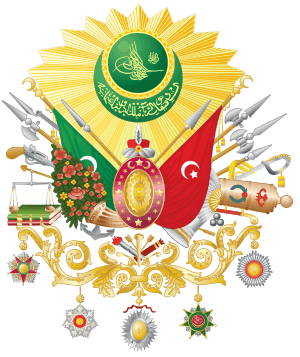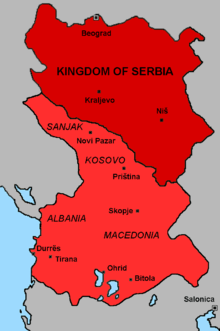Sanjak of Elbasan
The Sanjak of Elbasan (Turkish: İlbasan Sancağı) was one of the sanjaks of the Ottoman Empire. Its county town was Elbasan in Albania.
| Sanjak of Elbasan İlbasan Sancağı | |||||||||
|---|---|---|---|---|---|---|---|---|---|
| Sanjak of Ottoman Empire | |||||||||
| 1466–1913 | |||||||||
 Coat of arms
| |||||||||
.png) | |||||||||
| Capital | Elbasan | ||||||||
| History | |||||||||
• Construction of the Elbasan fortress | 1466 | ||||||||
| 1913 | |||||||||
| |||||||||
| Today part of | |||||||||
Administration
Although Halil Inalcik explains that the Sanjak of Elbasan was established as soon as the fortress of Elbasan has been constructed, based on Tursun Beg's records there is a possibility that Elbasan initially was part of the Sanjak of Ohrid.[1]
The Sanjak of Elbasan had three kazas:[2]
It became part of the Manastir Vilayet when it was established in the 19th century.[3]
Marino Bizzi, the Archbishop of Bar (Antivari), stated in his report that on May 17, 1591 that name of the sanjakbey of Sanjak of Elbasan was Mehmet Bey.[4]
During the reign of Köprülü Fazıl Mustafa Pasha (1637 – August 19, 1691) one of the sanjakbeys of Elbasan was Hasan Pasha.[5] In 1714 the sanjabey of the Sanjak of Elbasan was Zejnil-beg.[6] At the beginning of 20th century sanjakbey of Elbasan was Necib Efendi, who was transferred to another position in February 1904.[7]
History
Disestablishment

During the First Balkan War at the end of 1912 the Sanjak of Elbasan together with most of the territory of Albania was occupied and de facto annexed by the Kingdom of Serbia. The Sanjak of Elbasan was on 29 November included in the Serbian administrative system as a srez (Serbian: Срез Елбасан) within Drač County (Serbian: Драчки округ), one of four srezes (the other being Drač, Lješ, Tirana).[8] In 1914 Elbasan became a part of the newly established Principality of Albania, established on the basis of peace contract signed during the London Conference of 1912–13.[9]
Demographics
15th century
In 1467 many Christians from Skopje, Ohrid, Serres and Kastoria were forcibly deported to Elbasan.[10]
16th century
At the beginning of the 16th century the Sanjak of Elbasan had the highest population density of all Ottoman sanjaks in the Balkans, with 5.65 per square kilometre (14.6/sq mi).[11] Between 1520 and 1535 up to 94,5% population of the Sanjak of Elbasan were Christians.[12]
17th century
An Ottoman traveller Evliya Çelebi recorded in 1670 that Elbasan had 18 quarters with Muslim population and 10 quarters populated by an Orthodox and Roman Catholic population. He also stated that Serbs, Bulgarians and Voyniks (Ottoman Christian mercenaries) were not allowed to take up residence in Elbasan, otherwise they would be immediately slain according to ancient custom.[13] The Albanian language was spoken by all residents, most of whom also had an advanced knowledge of Turkish. The merchants could also speak Greek and Italian.
19th century
According to Russian consul in the Manastir Vilayet, A. Rostkovski, finishing the statistical article in 1897, the total population of the sanjak was 56,105. Albanian Muslims were 51,786, Albanian Christians were 3,319, and Vlachs (Aromanians) were 1,000.[14]
20th century
At the beginning of the 20th century it was estimated that 15,000 people lived in Elbasan, which was then the seat of a Greek bishop.[15] In the region between Elbasan and Berat there were numerous villages which population publicly declared themselves as Muslims, but privately practised Christianity.[16]
Albanians who lived in Elbasan were Tosks and because of that the Sanjak of Elbasan was seen as part of Toskalik, land of Tosks, together with the sanjaks of Ergiri, Preveze, Berat, Yanya, Gorice and Manastir. Tosks did not have a tribal society like Ghegs had.[17]
References
- Kiel, Machiel (1990), Ottoman architecture in Albania, 1385-1912, Istanbul: Research Centre for Islamic History, Art and Culture, p. 39, ISBN 978-92-9063-330-3, retrieved 9 January 2012,
...states that Elbasan became a sandjak capital right after 1466 but the usually well informed Tursun Beg noted for 1466: "The sultan attached this fortress of Elbasan to the Sancak of Ohrid and returned to Edirne..."
- "20. yüzyılda Osmanli Vilayetleri" (PDF) (in Turkish). http://tarihvemedeniyet.org/. Retrieved 28 July 2011.
İlbasan Sancağı ...İlbasan Liva merkezi Grameç Kaza merkezi Peklin Kaza merkezi
External link in|publisher=(help) - Ottoman Provinces before 1908
- Bizzi 1610.
- Jagoš, Jovanović (1947). Stvaranje Crnogorski države. Narodna Knjiga. p. 103. Retrieved 1 August 2011.
Под Ћуприлићевом командом били су скадарски Ахмед-паша, елбасански Асан-паша,
- Pelidija, Enes (1989). Bosanski ejalet od Karlovačkog do Požarevačkog mira, 1699-1718. Veselin Masleša. p. 82. Retrieved 1 August 2011.
Već 15. maja 1714...već krajem maja .. Numan paša je dobio ferman....Fermani sa sličnim pretnjama su dolazili....Elbasanskom Zejnil-begu
- Gawrych 2006, p. 110.
- Bogdanović, Dimitrije; Samardžić, Radovan (1990). Knjiga o Kosovu: razgovori o Kosovu. Književne novine. p. 208.
- Vickers, Miranda (1999). The Albanians: a modern history. I.B.Tauris. pp. 77, 78. ISBN 978-1-86064-541-9.
- Shukarova, Aneta; Mitko B. Panov; Dragi Georgiev; Krste Bitovski; Ivan Katardžiev; Vanche Stojchev; Novica Veljanovski; Todor Chepreganov (2008), Todor Chepreganov (ed.), History of the Macedonian People, Skopje: Institute of National History, p. 133, ISBN 9989-159-24-6, OCLC 276645834, retrieved 26 December 2011,
At the same time or nearly in 1467 the citizens from Skopje, ...were expa-triated to the Albanian city of Konjuh (Elbasan), which was constructedas a fortress to help the fighting against Skender-Bey. ... these Christians from Skopje as Elbasan’s citizens appeared other families from Ohrid, Kastoria and Serres that were compulsorily moved into this city..
- Vranjski glasnik, Volumes 17-19. Narodni muzej u Vranju. 1984. p. 26. Retrieved 1 August 2011.
1520....На Балканском полуострву само је Елбасански санџак имао већу густину живља (5,65)... In 1520... on Balkan peninsula only Elbasan sanjak had higher population density (5,65)...
- Zhelyazkova, Antonina (2000). "Albania and Albanian Identities". International Center for Minority Studies and Intercultural Relations. Retrieved January 10, 2011.
According to data published by Ö. Barkan, concerning the period of 1520–1535, the Christian population in the sancak of Elbasan ran up to 94.5 per cent.
- Chelebi, Evliya (1670), Robert Elsie (ed.), 1670 Evliya Chelebi: Seyahatname - a Journey to Berat and Elbasan, archived from the original on 2011-09-28
- "Jedna statistika iz srednje Maćedonije". Nova Iskra (15–16): 251. 26 July 1899.
- Raza, Moonis (1906). Geographical Dictionary Of The World In The Early 20th Century. Logos Press. p. 588. Retrieved 31 July 2011.
Elbassan, el-basvsan', a town of European Turkey, in Albania, 64 miles SE. of Scutari. It has numerous mosques and is the seat of a Greek bishop....Pop estimated at 15,000
- Gawrych 2006, p. 27.
- Gawrych 2006, p. 23.
Further reading
- Bizzi, Marino (1610). Elsie, Robert (ed.). "Relatione della visita fatta da me, Marino Bizzi, Arcivescovo d'Antivari, nelle parti della Turchia, Antivari, Albania et Servia alla santità di nostro Signore papa Paolo V". Archived from the original on 2009-09-11.CS1 maint: ref=harv (link)
- Chelebi, Evliya (1670). Elsie, Robert (ed.). "1670 Evliya Chelebi: Seyahatname - a Journey to Berat and Elbasan". Archived from the original on 2011-09-28.CS1 maint: ref=harv (link)
- Gawrych, George (2006). The Crescent and the Eagle: Ottoman Rule, Islam and the Albanians, 1874-1913. I.B.Tauris. pp. 23, 27, 110. ISBN 978-1-84511-287-5.CS1 maint: ref=harv (link)